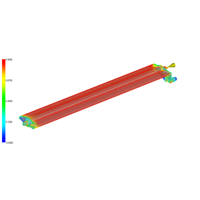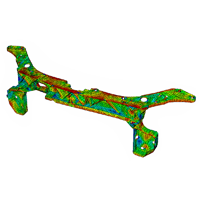
Modeling for Acoustics and Vibrations in Structural Engineering applications
Structural vibration can be a source for many product related problems; it can cause fatigue and durability problems as well as adverse reactions to the user or bystanders in the form of undesirable vibrations that can be felt or heard. As well, undesired structural vibrations can prevent products from operating as required and potentially becoming a safety concern.
Lightweight design with vibrational behavior identification
NVH (Noise, Vibration, and Harshness) or N&V (Noise and Vibration), this problem is one of the most often directly perceived quality traits of a product, and is therefore one of the most sought after targets for performance by the product development team to help differentiate themselves from competition.
This requires fine modeling of local stiffness throughout the structure to accurately identify its vibrational behavior.
Lightweighting of the part will be optimal and the number of calculation/testing iterations will be reduced, allowing the entire project to save time and cost.
In the automotive industry, a part made of fiber reinforced injected plastic represents a heterogeneous distribution of local stiffness. Lightweighting of the part will be optimal and the number of calculation/testing iterations will be reduced, allowing the entire project to save time and cost.
On the other hand, multi-scale modeling Digimat allows the project to access to new micro-structural design parameters, for both reinforced plastics and UD, woven or braided composites. To optimize the material cost and weight of the structure, the design team will be able to define the best percentage and the best orientation of fibers in the material directly in the design of components and the complete vehicle.
Digimat is used for many types of Noise and Vibration simulations:
- Complex Eigenvalues
- Frequency response analysis
- Frequency response function (FRF)
- FRF based assembly (FBA)
- Transfer path analysis
- Load identification
- Loads: Frequency or time dependent force, displacement, velocity, and acceleration
- Modal participation factor
- Normal mode analysis
- Random response analysis
- Transient response analysis
Application on Acoustics and Vibrations in the industry with Digimat modeling plateform:
- Aerospace & Defense:
Cabin comfort, interior compartments, blade modal analysis, fluttering, etc. - Automotive:
Fan flaps, planetary gearsets, cam cover, front end carrier, pan oil, engine mounts, etc.
| Industries:
Automotive Material:Short fiber reinforced plastic Overview:This flap, mounted on the fan system, is submitted to vibrational sollicitations. Its modal behavior has been simulated accurately thanks to the Digimat technology for short fiber reinforced plastic applications. A multi-scale material model is calibrated with Digimat MF/MX. The injection process is simulated in order to provide the heterogeneous field of the fiber orientation. This is mapped with Digimat MAP onto the structural mesh. The use of Digimat multi-scale material model in the coupled FE analysis drives to a reduction of the error from more than 14% with an isotropic definition of the material to less than 5% compared to the experimental modal basis. |
  DOWNLOAD DOWNLOAD |
| Industries:
Automotive Material:Long fiber reinforced plastic Overview:The simulated performances on this front end carrier are the stiffness under static load and the identification of the modal basis. The results of the simulations, realized with a multi-scale material model taking into account the influence of the manufacturing process on the field of fiber orientation, has been successfully compared to experimental tests, providing a better level of accuracy than the usual isotropic method. In addition, thanks to the use of the Digimat technology the cost and delay of several experimental tests has been saved. These tests were required previously to calibrate the isotropic material model. |
  DOWNLOAD DOWNLOAD |
